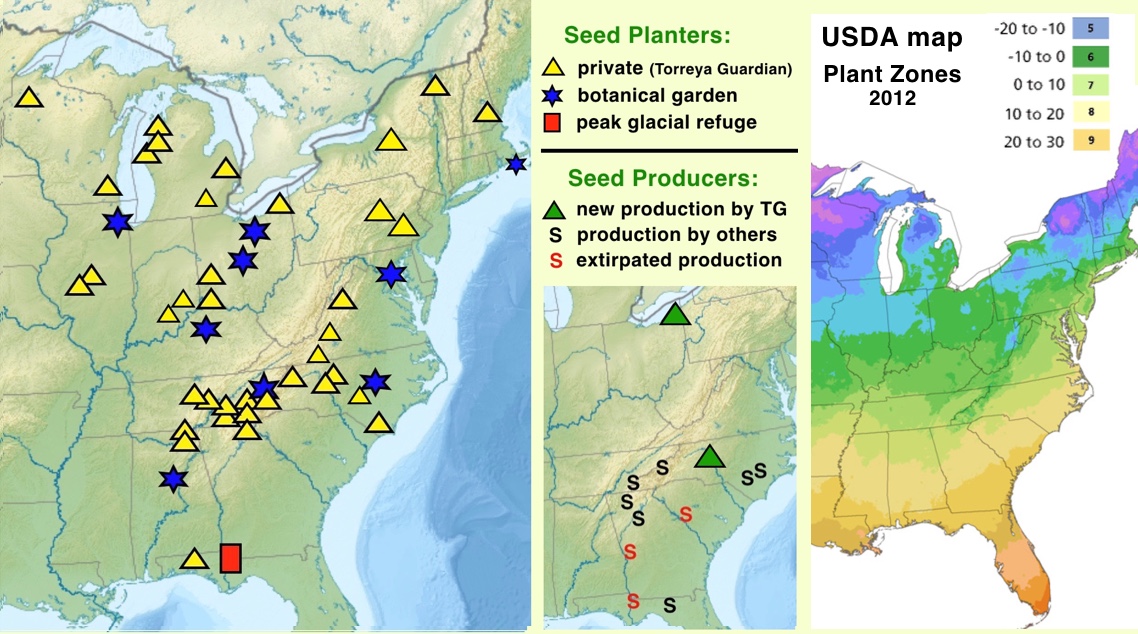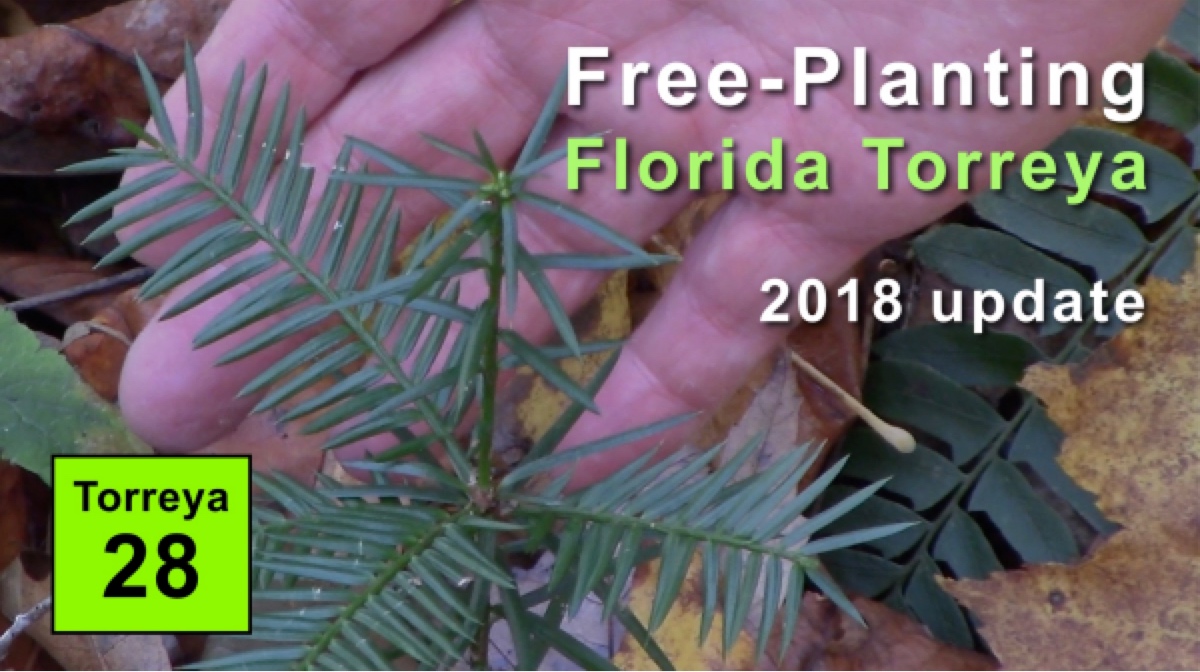• BACKGROUND: Florida Torreya Recovery Efforts — Official and Volunteer
OFFICIAL ACTIONS: Torreya taxifolia was declared "endangered" under the USA Endangered Species Act in 1984. Within its native range (a peak glacial refuge in northern Florida) seed production had virtually ceased several decades before listing. Therefore, a crucial first action was for professionals to collect branchlets onsite from all the remaining wild trees and then to root those samples in misting facilities of several northward botanical gardens. STEP 1 of the official recovery program, "genetic safeguarding," was very successful.
"Ex situ" plantings" of a diversity of sexually mature shrubby specimens grown from rooted branchlets constituted the second phase of recovery action. Sites in northern Georgia (geographically, the southernmost extent of the Appalachian Mountains) were selected for the out-plantings. Although ex situ seed production from 2007 through 2017 was officially undocumented and uncollected (and no online documentation is apparent even in 2022), observers have noticed that the pair of ex situ "orchards" had been producing hundreds and, since 2013, thousands of seeds annually. STEP 2, "ex situ plantings" (for both genetic safeguarding and seed production), has thus been successful, too.
VOLUNTEER ACTIONS: Meanwhile, since 2005, TORREYA GUARDIANS volunteers have engaged in a variety of independent projects aiming toward recovery of this climate-endangered conifer tree — mostly via "assisted migration" northward.
Planting projects have been testing the climate and habitat suitability of northward sites (see map below). Northward experimentation depended on acquiring potted seedlings from nurseries and, increasingly, receiving donations of seeds from privately owned mature trees (see map below). Seeds have been sourced in North Carolina (Biltmore Gardens near Asheville, Harbison House near Highlands, the Kennedy home in Clinton, and the A. J. Bullard home in Mt. Olive). Beginning in 2018, Briarwood Preserve became another source, as did the 11-year-old grove of our Cleveland OH planter, Fred Bess.

Documentation and interpretation of all seed-producing groves is a noteworthy contribution made by Torreya Guardians toward species recovery. Evidence of climate and habitat suitability of these long-established northward plantings offer encouragement for managers to undertake "assisted migration" as STEP 3 of the official program. Toward this end, a photo-rich compilation of these Historic Groves was added to this website in 2018. Torreya has demonstrated in these historic groves its ability to thrive, produce seeds, and establish seedlings naturally in northward latitudes — while remaining noninvasive.
• Why Free-Planting Seeds Is Important
Seeds produced in the official ex situ groves in northern Georgia (Smithgall Woods and Blairsville) have become numerous enough to merit an official declaration of "nonessential." Such declaration would then make seeds available for a next phase of official field experimentation, STEP 4: "free-planting" seeds directly into selected northward forested sites. Given governmental budgetary constraints, it is unlikely that full recovery and delisting of Torreya taxifolia can be accomplished in labor-intensive and costly ways (e.g., producing potted seedlings and later transporting them to and planting them in ultimate destinations). Accordingly, it is vital to ascertain best practices for safely, yet inexpensively, introducing seeds directly into forest habitats — without first germinating them in protected settings (such as wire-protected soil beds or pots in botanical gardens).
Since 2013, a growing number of Torreya Guardians have been legally experimenting (beyond the constraints of the governmentally sanctioned recovery plan) with techniques for skipping the potted seedling step in torreya propagation. Instead, harvested seeds are being put directly into forest habitats as their ultimate destinations. Torreya Guardians founder Connie Barlow has been the chief proponent of free-planting experiments and has been photo- and video-documenting ongoing results.
HEALTH BENEFITS:
"Mycorrhizal networks are important for seedling establishment in perennial vegetation. The fact that seedlings that germinate in perennial communities, with existing mycelial networks, often become quickly colonized by mycorrhizal fungi (e.g. within 3 to 6 days after seedling emergence) is probably very important because small seedlings then have immediate access to a low-cost 'nutrient adsorption machine', provided and maintained by the surrounding vegetation." — Marcel Van der Heijden et al., "Mycorrhizal Ecology and Evolution: The past, the present and the future", 2015, New Phytologist
• Status of Free-Planting Experiments
This page (established December 2018) posts the highlights of ongoing free-planting experiments by Torreya Guardians. Learnings will be offered, while inviting others to join in interpreting the ever-expanding field evidence.
Note: The Federal Register August 2018 notice that Florida Torreya's recovery plan will be open to updating is the event that compelled Barlow to establish this photo-rich webpage of summary results.
VIDEO 28: Free-Planting Climate-Endangered Florida Torreya - 2018 Update
 |
|
Field documentation of the 6 seedlings that grew and survived with zero human help, following "free-planting" of 15 seeds directly into forest soil in April 2015. Russ Regnery was the planter, within his forest at 3,800 feet elevation on the slope of Black Rock Mountain, near Franklin NC. Video clips of the 2015 planting (Episode 12) are matched with the actual seedlings closely photographed and analyzed Nov 2018.
37 minutes - filmed November 6, 2018
|